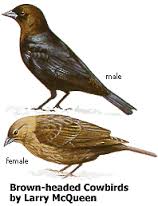The bird world is a fragile one, as survival depends on being able to lay eggs and protect them or reject eggs that “brood parasites” can sneak into other birds’ nests. “Brood parasites” is a term referring to birds that don’t build nests of their own but prefer to use other birds’ nests. And researchers have been fascinated for a long time about how these creatures identify and reject these foreign eggs.
They have used wood and plaster for artificial eggs during research, but these artificial eggs have proven to be ineffective because traditional materials like plastic, wood, and plaster-of-Paris can be time-consuming to make, they yield many human errors, and they are difficult to replicate (an important aspect of research is uniform materials).
And you see where this is going, right? Researchers hatched the idea to create digital models of brown-headed  cowbird eggs — a well-known North American brood parasite.) Then the eggs were 3D printed, which allowed for hollow eggs that can replicate the real ones because water or gel inside the egg can mimic the real eggs’ weight and thermodynamic properties.
cowbird eggs — a well-known North American brood parasite.) Then the eggs were 3D printed, which allowed for hollow eggs that can replicate the real ones because water or gel inside the egg can mimic the real eggs’ weight and thermodynamic properties.
According to the article “Using 3D printed eggs to examine the egg-rejection behavious of wild birds” which is published on PeerJ, the article’s authors summarize how beneficial 3D printing is for this bird behavior research.
“3D printing technology is less prone to human error and allows precise and controlled manipulation of one, or several, egg traits, including shape, weight, and texture. Therefore, it can both eliminate unwanted variability in mass production of identical stimuli eggs and also allow precise control of how much, and in which parameters, eggs vary. Lastly, digital 3D models can be easily shared online for other researchers to use, enabling more replicable use of experimental stimuli eggs across different laboratories, continents, and study species, than is possible with traditional
methods for making artificial eggs.”
The reserachers used Blender Foundation’s open-source 3D graphics software and based egg model design on a photograph. The design was then printed using ABS on a Makerbot Replicator 2X 3D printer, with egg dimensions at anywhere from 19–24.4 mm in length to 14.4–18.1 mm in breadth; the variation in size reflects real egg phenotype variation. The eggs were then printed with four internal shell layers built on top of eachother, using 0.3 and 0.2 mm layer thicknesses, and 0% infill. A syringe was used to fill these eggs with water and then seal them by dissolving ABS in acetone to create a thick paste. More acetone was added to this ABS-acetone glue and the entire egg surface was coated with this substance to ensure a watertight egg. The egg surfaces were then sanded smooth and painted; cowbird-eggs beige and robin’s egg blue-green.
Once the eggs were made and prepped, how were they used and what were the results? The 3D printed eggs were placed in robin’s nests with parents’ behavior monitored for six days. Robins accepted 100% of the blue-green eggs but rejected 79% of the cowbird eggs. This is similar to past results that used traditional plaster eggs.But as the authors remind us, the 3D printed eggs have the advantage of uniformity for consistency’s sake. Also, digital modeling is easy for researchers to share.
It appears that ornithologists have hatched a great idea in 3D printed eggs! Let us know your thoughts on this study in the 3D Printed Bird Egg forum thread on 3DPB.com.

Subscribe to Our Email Newsletter
Stay up-to-date on all the latest news from the 3D printing industry and receive information and offers from third party vendors.
Print Services
Upload your 3D Models and get them printed quickly and efficiently.
You May Also Like
Consolidation in AM: How 2025 Is Shaping the Industry’s New Normal
The first half of 2025 has been marked by a clear shift in the additive manufacturing (AM) industry. Companies are no longer just focused on developing new tech by themselves....
Etsy Design Rule Change Reduces Selection of 3D Printed Goods
Online marketplace Etsy has implemented a rule change requiring all 3D printed goods on the site to be original designs. The update to the site’s Creativity Standards states, ¨Items produced using...
U.S. Congress Calls Out 3D Printing in Proposal for Commercial Reserve Manufacturing Network
Last week, the U.S. House of Representatives’ Appropriations Committee moved the FY 2026 defense bill forward to the House floor. Included in the legislation is a $131 million proposal for...
Transforming From Tourist to Native: Duro CEO Michael Corr Explains Why the Company Rebuilt its PLM Software on AI
In these early innings of the AI boom, many market analysts have expressed concern that AI spend has gotten too far ahead of the technology’s proven ability to deliver significant...

































